Shrimp and broccoli stir-fry is a beloved dish that combines the delicate flavor of shrimp with the crispiness of broccoli, creating a nutritious and flavorful meal. While many home cooks strive to recreate the taste of authentic Chinese-style stir-fries, few know the secrets behind achieving that perfect balance of textures and flavors. In this article, we’ll explore everything you need to know to make the best shrimp and broccoli stir-fry, including tips for achieving that signature garlic sauce, understanding the health benefits, and even how to customize the dish with various ingredients and serving options. Whether you’re a seasoned chef or new to the kitchen, this guide will provide you with all the information needed to master this classic dish.
Key Takeaways
– Shrimp and Broccoli Stir-Fry: A Nutritious Choice – Packed with protein, vitamins, and minerals, shrimp and broccoli provide a balanced meal, supporting muscle repair, immune function, and overall health.
– Health Benefits of Shrimp and Broccoli –Rich in omega-3 fatty acids, vitamin C, vitamin K, and fiber, this dish supports heart health, bone strength, and weight management.
– Healthy Cooking Methods – Opt for steaming or stir-frying to maintain the dish’s nutritional value and reduce fat content.
– Authentic Chinese Recipe Tips – Use fresh shrimp, broccoli, garlic, soy sauce, and minimal oil for a flavorful and healthier version.
– Calorie Awareness – A typical serving ranges between 200-300 calories, depending on preparation.
– Brown Rice for Added Fiber – Choosing brown rice boosts fiber intake, making the meal more nutritious.
– Sauce Secrets – The tangy, savory sauce enhances flavor with ingredients like garlic, ginger, soy sauce, and hoisin sauce.
– Customizable Dish – Adjust spice levels, thickness, and serve over rice for personalized preferences.
– Broader Healthy Options – Incorporate steamed brown rice, vegetables, tofu, and edamame for a balanced, nutrient-rich meal.
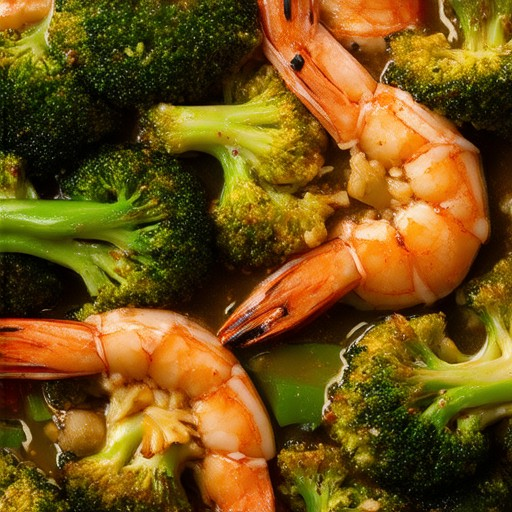
Does Broccoli Need to Be Steamed Before Stir-Frying?
Broccoli does not require steaming before stir-frying. You can successfully cook broccoli directly in a hot pan with a small amount of liquid, such as water or broth, allowing the steam from the heat to tenderize it. This method preserves its crispness and nutrients while making it flavorful.
However, the approach may vary slightly depending on the size of the broccoli florets. Larger pieces may benefit from a brief steam to prevent them from becoming too tough, while smaller florets can cook evenly in the pan without prior steaming. Experiment with different sizes and methods to find your preferred texture.
For optimal flavor, consider adding a drizzle of oil or a sprinkle of butter to the pan while cooking. This enhances the natural sweetness of the broccoli, making it a delicious addition to your stir-fry dish.
How Do Chinese Restaurants Make Shrimp So Tender?
Chinese restaurants employ several techniques to ensure shrimp remain tender and flavorful. Here’s a breakdown of the methods they use:
- Velveting Technique: Shrimp are coated in a mixture of cornstarch and egg wash before cooking. This creates a velvety texture and prevents the shrimp from becoming rubbery.
- Marinating: A short marination in a mixture of soy sauce, garlic, ginger, and sometimes rice wine helps infuse flavor and keep the shrimp moist during cooking.
- Quick Stir-Fry: In wok-based dishes, shrimp are cooked quickly over high heat, which sears the exterior while keeping the center tender and juicy.
- Steaming: Some dishes opt for steaming, which gently cooks the shrimp, locking in moisture and ensuring a delicate texture.
Why These Methods Work
The key to tender shrimp lies in slow, controlled cooking. Velvet coating and marinating add a protective barrier, while techniques like quick stir-frying and steaming ensure internal moisture isn’t lost during cooking. Overcooking is the primary culprit for tough shrimp, so these methods help prevent that.
Final Thoughts
By using a combination of these techniques, Chinese restaurants can serve shrimp that are perfectly tender, flavorful, and visually appealing. Try these methods at home for a restaurant-quality dish!
For more seafood cooking tips, visit us at Only Fish Recipes .
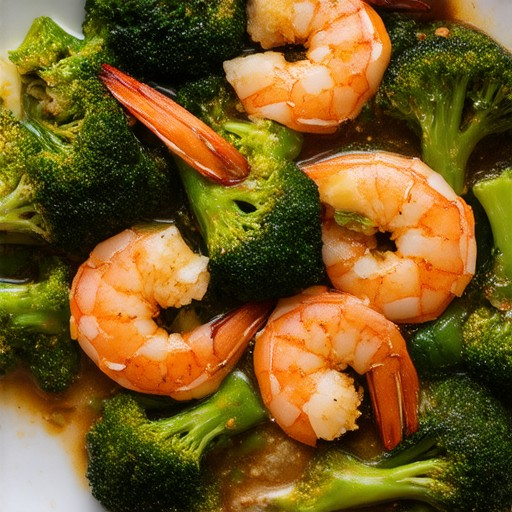
What Are the Three Rules of Stir-Frying?
We believe in making every meal special, and our stir-fry recipe is no exception. Here are the three essential rules to master the art of stir-frying:
- Rule 1: Separate Cooking We cook proteins and vegetables separately before combining them. This ensures everything stays crispy-tender and flavorful. Start by heating oil in a pan, then sauté proteins until just done, set them aside, and cook veggies until vibrant and slightly crunchy.
- Rule 2: One Vegetable at a Time For the perfect texture, we recommend stir-frying one vegetable at a time. Overcrowding the pan can lead to uneven cooking. Focus on getting each ingredient to cook evenly without overcrowding.
- Rule 3: Add Liquid Wisely We add liquid, like broth or sauce, only after everything else is nearly cooked. This helps develop deep flavors without steaming the veggies or burning the proteins.
By following these steps, you’ll achieve perfectly textured, flavorful stir-fries every time. Experiment with different proteins and veggies to keep your meals exciting!
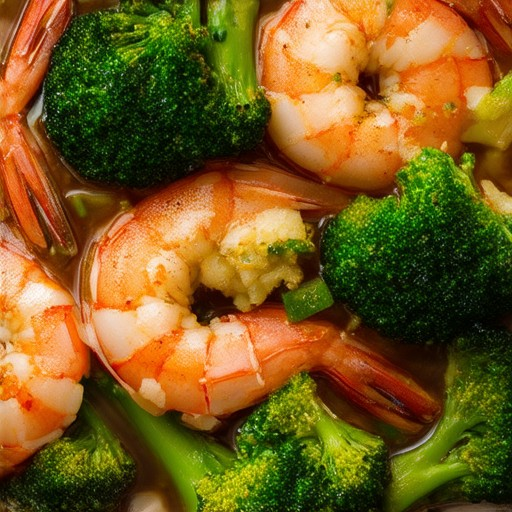
Is Shrimp and Broccoli Healthy from a Chinese Restaurant?
Yes, shrimp and broccoli, particularly in a well-prepared Chinese dish like shrimp and broccoli stir-fry, can be a healthy option. It’s rich in protein, vitamins, and minerals, making it a balanced choice for many diets.
Nutritional Value
- Protein: Shrimp is an excellent source of high-quality protein, essential for muscle repair and growth.
- Vitamins: Broccoli is packed with vitamin C and K, which support immune function and blood health.
- Minerals: Shrimp provides zinc and selenium, while broccoli offers calcium and iron.
- Fiber: Both shrimp and broccoli are low in calories and high in fiber, helping regulate digestion.
Health Benefits
- Heart Health: Shrimp contains omega-3 fatty acids, which may reduce the risk of heart disease.
- Bone Health: Broccoli is rich in vitamin K, which is important for blood clotting and bone health.
- Weight Management: The combination of lean protein and fiber helps in managing weight and reducing hunger.
Cooking Methods
When ordering at a Chinese restaurant, opt for steaming or stir-frying to keep the dish healthier. Avoid heavy sauces or breading, which can increase calories and fat content.
Chinese Shrimp Recipe Tips
- Ingredients: Look for fresh shrimp and broccoli, often served with garlic, soy sauce, and rice.
- Preparation: Many restaurants use minimal oil, ensuring a lower-calorie meal. Ask for extra vegetables for added fiber.
- Calories: A typical serving is around 200-300 calories, depending on the restaurant’s preparation method.
Alternative Options
If you prefer, consider requesting brown rice instead of white rice for more fiber and nutrients.
Overall, shrimp and broccoli prepared in a healthy manner, such as in a Chinese stir-fry, can be a nutritious and satisfying meal choice.
What is the Sauce on Chinese Shrimp and Broccoli?
The dish of Chinese shrimp and broccoli is a flavorful and nutritious meal that often comes accompanied by a tangy and savory sauce. This sauce typically complements the subtle flavors of the shrimp and the crispiness of the broccoli, making the dish both delicious and well-balanced.
Key Ingredients of the Sauce
- Olive Oil or Sesame Oil: Provides a healthy base and adds a rich flavor to the dish.
- Garlic: Enhances the aroma and adds a hint of sweetness when sautéed.
- Ginger: Adds a spicy kick and freshening the taste.
- Soy Sauce: A staple in many Asian dishes, it adds umami and depth to the sauce.
- Hoisin Sauce: Offers a sweet and savory balance to the dish.
- Red Pepper Flakes (Optional): Adds heat for those who enjoy spicy food.
Preparation Steps
- Start by heating a pan over medium heat and adding a tablespoon of olive oil or sesame oil.
- Add minced garlic and ginger, sautéing for about 30 seconds until fragrant.
- In a separate bowl, mix together soy sauce, hoisin sauce, and red pepper flakes (if using) along with a splash of water or broth.
- Pour the sauce mixture over the shrimp and broccoli, stirring everything together to coat evenly.
- Cook for about 5-7 minutes, depending on the size of the shrimp, until they are fully cooked and the broccoli is tender-crisp.
Tips and Variations
- You can adjust the level of spice by adding more or less red pepper flakes.
- For a sweeter sauce, you can increase the amount of hoisin sauce.
- Adding a bit of cornstarch mixed with water can thicken the sauce if needed.
- Serve over rice for a complete meal.
This sauce is a perfect blend of sweet, savory, and slightly spicy flavors, making it a versatile option for various types of seafood and vegetable dishes.
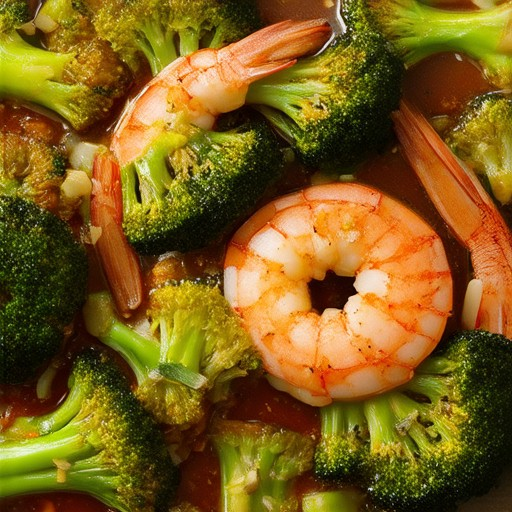
What is the healthiest Chinese food I can eat?
When exploring Chinese cuisine, there are plenty of nutritious and delicious options that align with a healthy lifestyle. Here are some of the healthiest Chinese foods to consider:
- Steamed Brown Rice : A complex carbohydrate that provides sustained energy and fiber, helping regulate blood sugar levels.
- Sautéed or Steamed Vegetables : Rich in vitamins, minerals, and antioxidants, these are a great source of dietary fiber and essential nutrients.
- Spring Rolls : Typically low in calories and fat, these are a lighter option that can be made with minimal oil and filled with vegetables.
- Egg Drop Soup : A broth-based soup packed with protein, vegetables, and sometimes added mushrooms for extra nutrients.
- Veggie-Based Dishes : Options like stir-fried tofu, braised bamboo shoots, and cucumber salad are excellent sources of plant-based protein and fiber.
- Edamame : A versatile legume high in protein and fiber, perfect as a snack or part of a meal.
- Lettuce Wraps : A low-calorie option that can be filled with lean meats, tofu, or vegetables for a balanced meal.
- Braised Bamboo Shoots : A unique ingredient rich in dietary fiber and antioxidants, commonly paired with vegetables and light sauces.
- Cucumber Salad : Refreshing and hydrating, this dish often includes herbs, garlic, and a light dressing, making it a healthy side option.
- Hot and Sour Soup : A tangy soup that includes ingredients like tofu, mushrooms, and chili peppers, providing a good mix of flavors and nutrients.
- Seaweed Snacks : High in iodine and other minerals, these are a crunchy and satisfying snack option.
- Stir-Fried Tofu : A protein-rich dish that can be prepared with minimal oil and a variety of colorful vegetables.
- Buddha’s Delight : A traditional dish featuring a medley of roasted fruits, nuts, and seeds, offering a nutrient-dense combination.
For a truly balanced meal, pair these foods with a variety of proteins, whole grains, and vegetables. Remember to opt for healthier cooking methods like steaming, stir-frying, or braising to reduce fat content.
Looking for more recipe ideas? Explore our collection of healthy Chinese recipes designed to fuel your body and satisfy your taste buds!

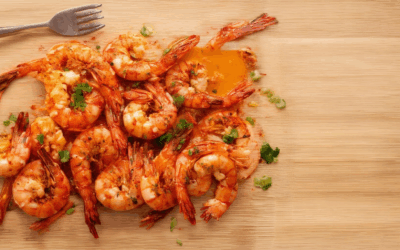
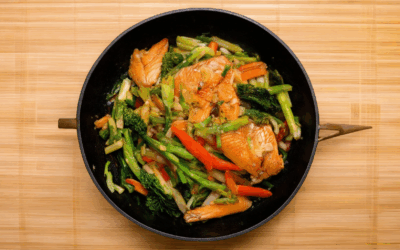
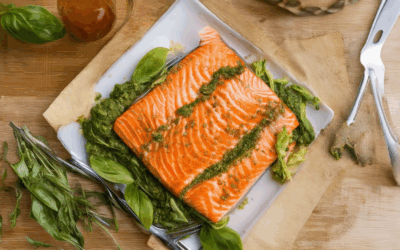
0 Comments